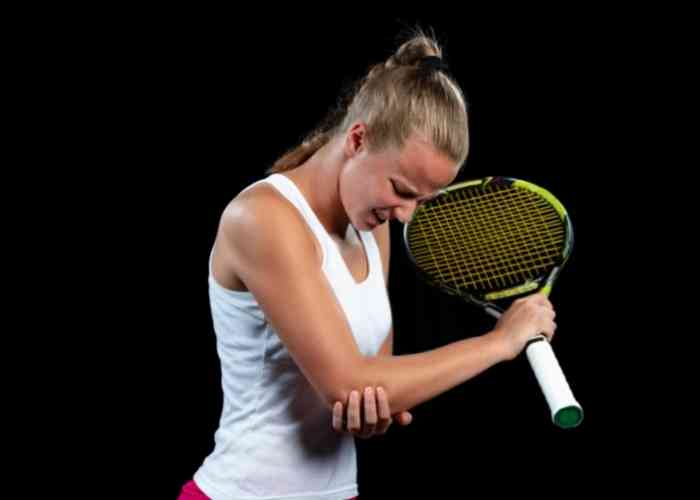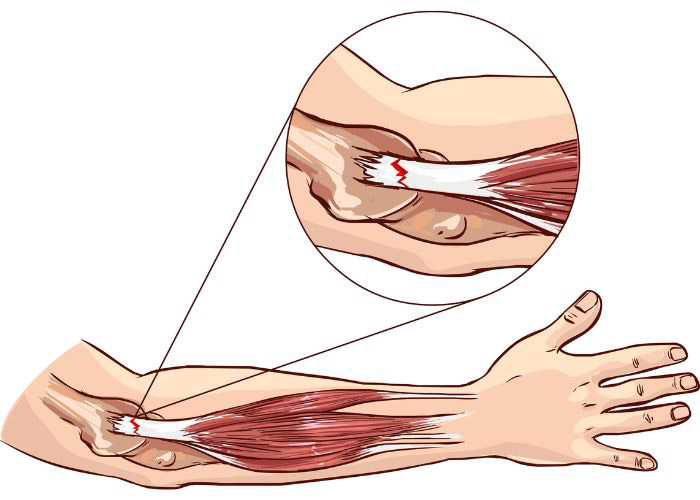What is tennis elbow or lateral epicondylitis?
Lateral epicondylitis, more commonly known as Tennis elbow, is a common condition that results from repeated stress to the back of the forearm. The extensor carpi radialis brevis muscle is attached to the lateral epicondyle, a bony prominence on the humerus (upper arm bone), by the common extensor tendon. When this muscle is overexerted through tennis and other racket sports, the repetitive stress onto the common extensor tendon can cause damage. When damage to the tendon is not allowed to properly heal, it can lead to pain of the outer (lateral) portion of the elbow resulting in Tennis elbow. Dr. Ronak Mukesh Patel, orthopedic elbow specialist serving patients in Sugar Land, Pearland, and the Houston, Texas area, has the knowledge and understanding, as well as substantial experience in treating patients who have experienced Tennis elbow.

What is an extensor tendon tear?
The common extensor tendon is a fibrous tissue band that is responsible for anchoring the posterior forearm muscles to the lateral epicondyle of the humerus. The extensor carpi radialis brevis (ECRB) muscle has the most prominent tendon for attachment therefore the other tendons integrate into the ECRB tendon to form the common extensor tendon. The ECRB muscle is responsible for extending the wrist as well as stabilizing the wrist when the elbow is straight. When the ECRB muscle or any of the other extensor muscles are continually used, the repeated stress on the associated tendon can cause small tears to develop leading to lateral epicondylitis.

What are the symptoms of Tennis elbow?
The pain associated with Tennis elbow typically begin as a mild ache and progressively worsen with time. Individuals with suspected Tennis elbow frequently report pain localized over the lateral epicondyle on the outside of the elbow. Some other common complaints of Tennis elbow include:
- A constant dull ache on the outside of the affected elbow
- Pain that may radiate into the upper arm or into the forearm
- A weak grip that makes it difficult to hold a cup of coffee or turn a doorknob
How is Tennis elbow diagnosed?
Dr. Patel will begin by gathering a comprehensive medical history that includes any previous elbow injuries, underlying medical conditions that may contribute to Tennis elbow, work or sports-related activities, and current symptoms. This medical interview will be followed by a physical examination with specific testing such as straightening the fingers and wrist against resistance and palpating the lateral epicondyle of the affected elbow for any pain and tenderness. Diagnostic imaging studies, such as x-rays and magnetic resonance imaging (MRI), may be performed to evaluate the surrounding elbow structures for any damage. Nerve conduction studies and electromyography (EMG) may be requested by Dr. Patel to rule out nerve compression for patients with symptomatic nerve damage.
What is the treatment for Tennis elbow?
Non-surgical treatment:
The majority of patients with Tennis elbow frequently respond well to conservative therapies alone. There are a number of non-invasive treatment options available for patients with Tennis elbow, including:
- A specialized brace can be situated over the forearm muscles to help the muscles and tendons adequately rest to allow the injury to properly heal.
- Modifying or limiting activity with a combination of rest, ice, compression, and elevation can substantially relieve symptoms during the healing process.
- The pain and inflammation associated with Tennis elbow can be alleviated with over-the-counter non-steroidal anti-inflammatory medications (NSAIDs).
- Corticosteroid Injection. If the pain and inflammation still persist with oral medications, a corticosteroid injection can be administered.
- Platelet-Rich Plasma (PRP). A newer alternative treatment option involves administering a highly concentrated mixture of the patient’s own platelets directly into the injury site.
- Physical Therapy. Participation in a physical therapy program can strengthen the forearm muscles and tendons to prevent further damage to the elbow.
Surgical treatment:
Patients that experience persistent and severe elbow pain or fail to respond to initial conservative therapies may require surgical intervention. Dr. Patel can repair the damaged tendons by surgical methods. Open surgery is preferred, where this standard treatment method involves a small incision over the lateral epicondyle and specialized surgical instruments are used to repair and reattach the tendon back to the lateral epicondyle after debridement of abnormal tissue. To determine the appropriate surgical approach, Dr. Patel will review the patient’s age, activity level, medical history, and desired recovery goals.
Tennis Elbow Specialist

You do not need to be a tennis player to experience the symptoms of tennis elbow. Repetitive motions of the arm and elbow can cause painful symptoms of lateral epicondylitis, most commonly referred to as tennis elbow. Tennis Elbow specialist, Doctor Ronak Mukesh Patel, provides diagnosis as well as surgical and nonsurgical treatment options for patients in Houston, Sugar Land, and Pearland, TX who are experiencing symptoms of lateral epicondylitis or tennis elbow. Contact Dr. Patel’s team today!


